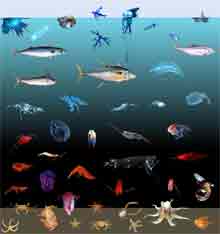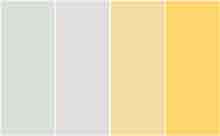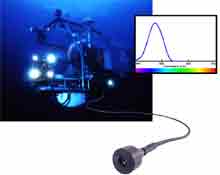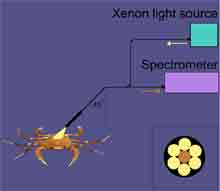
Figure 1: The coloration of oceanic animals, shown as a function of depth. Click image for larger view.
Measuring the Color of Deep-sea Animals
Sönke Johnsen
Assistant Professor
Duke University
Unlike animals on land or in shallow water -- where skin, fur, and feather coloration may differ within habitats like hues on an artist's palette -- deep-sea animals follow a surprisingly regular pattern in their coloration (Figure 1). Blue animals live near the surface. Deeper down, animals are blue on top and white on the bottom. At greater depths, animals are generally transparent, but have red stomachs. Below that, animals are red or black over their entire bodies. Finally, at the bottom, almost all animals are either a pale red or a cream color. The most likely explanation for this distribution is camouflage (color that blends in with the surroundings).

Figure 2: The color of a light gray piece of paper viewed under (left to right) daylight, direct sunlight, fluorescent light, and incandescent bulb. Click image for larger view.
So a cryptic animal (with coloring for concealment) has to worry both about the color of the background and the color of the surrounding light. Benthic (bottom-dwelling) animals are exempt from this problem. Since both the background and the animal are illuminated by the same light, the animal doesn't have to worry about this factor. Animals swimming in the water do, though, because the background light isn't affected by the surrounding light in a simple way. Therefore, we need to measure both the animal's spectral reflectance (color) and the color of the surrounding light.
Measuring Surrounding Light
We measure the surrounding light in several ways. When possible, we measure the light directly by transporting a sophisticated light meter down in a submersible and taking measurements through a fiber optic cable that goes from the inside of the sub to the outside (Figure 3). When direct measurements are not possible, we model the light field.

Figure 3: The Johnson-Sea-Link submersible, with a fiber optic cable attached to it, and a representative spectrum (inset). Click image for larger view.
We do this by taking measurements of how light is affected by small amounts of water and then calculating what a much larger volume of this water will do. Because ocean water is quite clear and empty, this method works well.
Measuring Animal Color
To measure the animals' colors, we must first catch them in a fashion that doesn't damage their surfaces. This is done using collection equipment on the submersible, special trawl nets designed to capture more delicate animals, and scuba divers working near the surface.
Once caught, the animals' colors are measured using a specially designed spectrometer (Figure 4). The best way to describe the process is to "follow" a beam of light through the apparatus.
First, a xenon light bulb generates the light. These bulbs, used in photographic flashes, are extremely bright and emit light both at visible and ultraviolet wavelengths. The light enters a special fiber optic cable that has six smaller cables within it. The cables allow us a great deal of flexibility in designing equipment (which is important at sea) and also protect us from accidentally looking at bright ultraviolet light, which can damage eyes. The light leaves the cable and illuminates the surface of the animal we are measuring. Some of this light is absorbed and some of it may pass through the animal (if it is transparent). The rest reflects off the surface of the animal. One fiber at the center of the special cable collects this reflected light and sends it to a spectrometer. The spectrometer measures the brightness of this light at all wavelengths, from the ultraviolet to the blue and on up to the red portion of the spectrum.

Figure 4: A schematic diagram of the apparatus used to measure reflectance. The arrows show the direction of the light. The inset shows the cross-section of the fiber optic cable. Click image for larger view.
The reflectance measurements from a large number of animals from many species are then added to the measurement of the surrounding light. This determines the color of these animals at depth and how well camouflaged they are.























